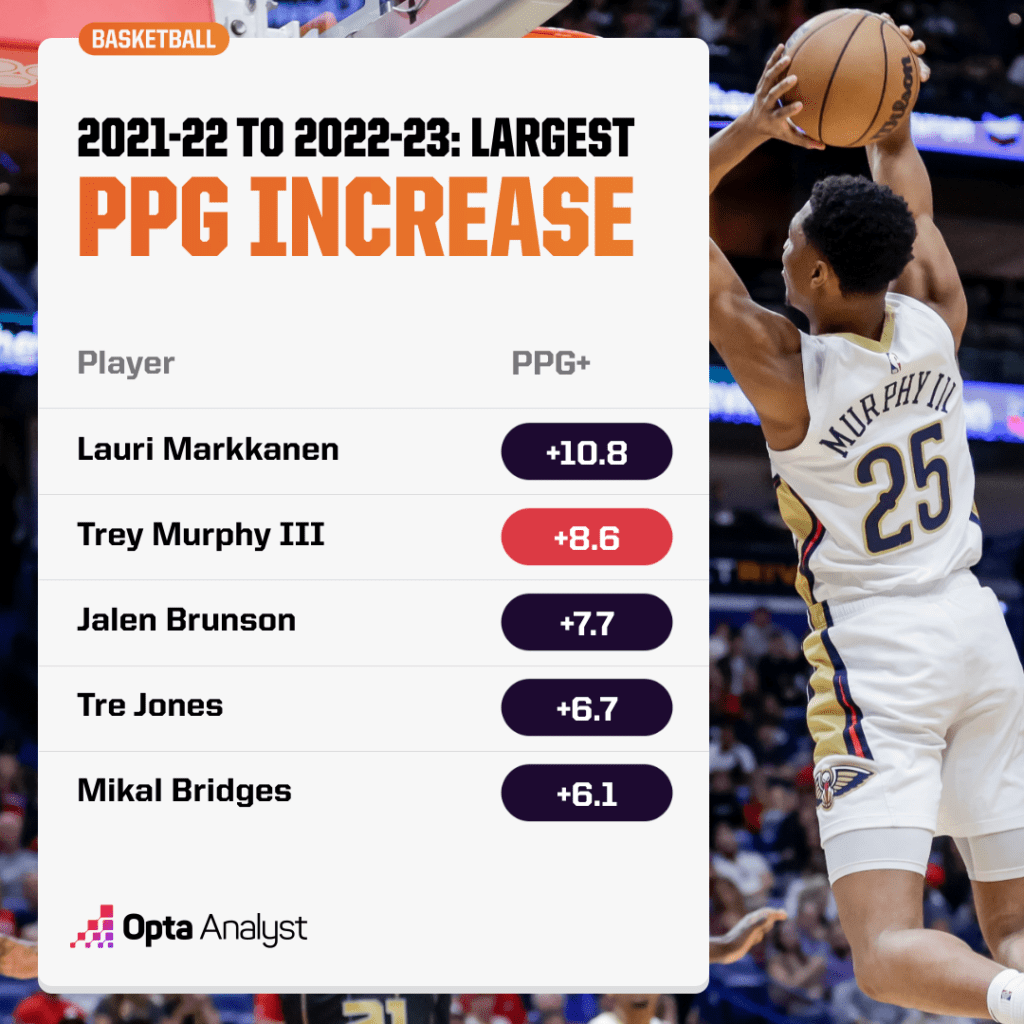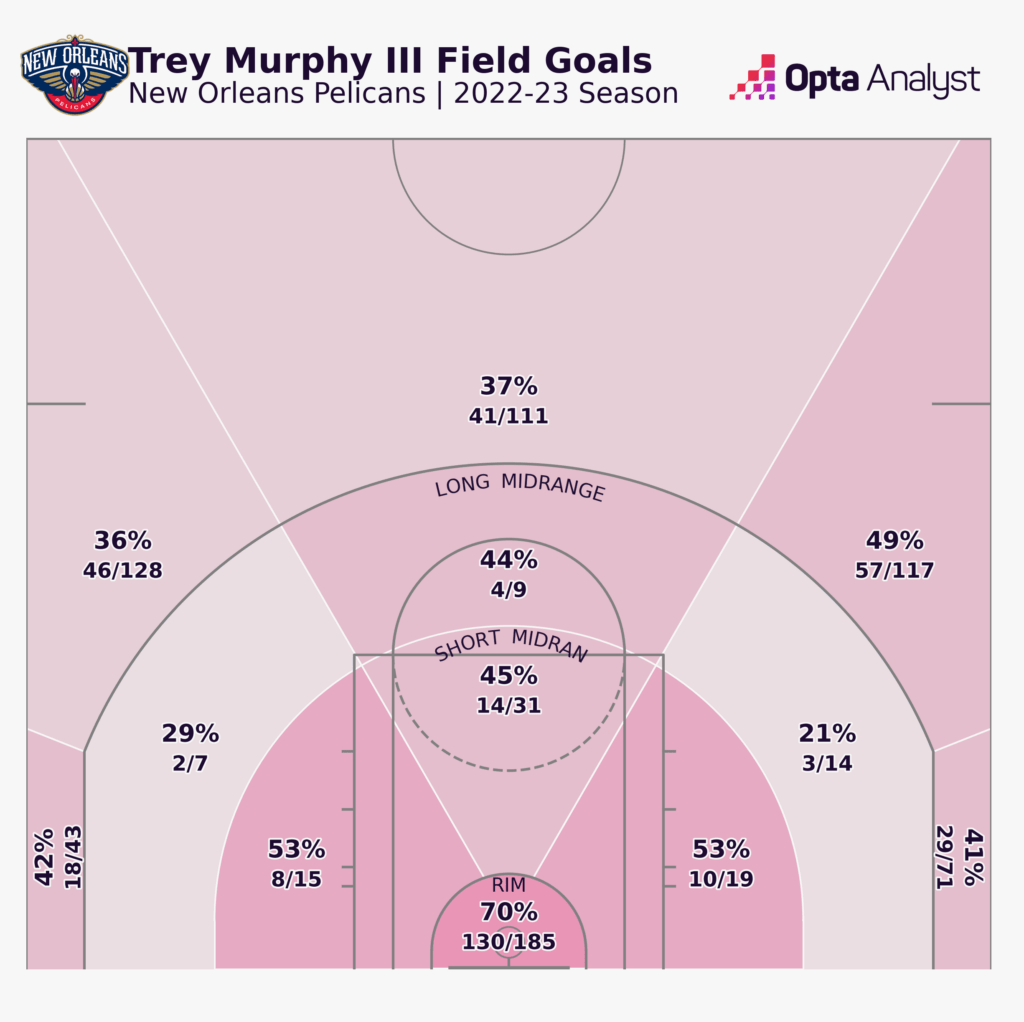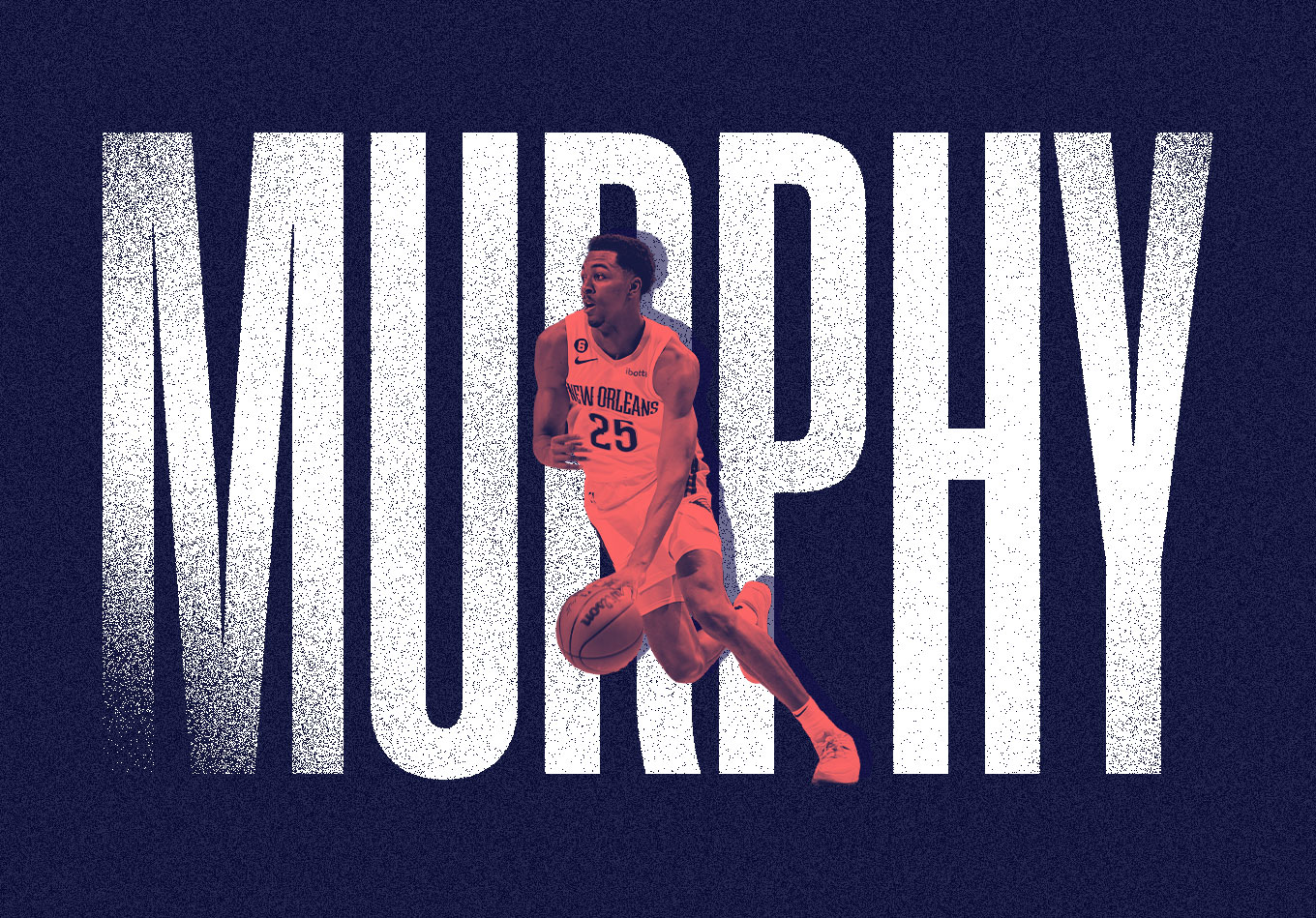Among the entire 2021 rookie class, perhaps nobody has made more significant strides in Year 2 than New Orleans Pelicans wing Trey Murphy III.
Contemporaries such as Evan Mobley, Josh Giddey, Franz Wagner and Quentin Grimes have all showcased sizable leaps between their first and second seasons, yet Murphy’s development likely warrants the gold medal
Last year, the former Virginia Cavalier played 13.9 minutes per night, averaging 5.4 points, 2.4 rebounds and 0.4 steals. Although he established some stability in the final two months of the year and displayed the long-range exploits (38.2% beyond the arc) that rendered him a top-20 selection, a 30-minute role the following season would require substantial improvements.
Murphy’s ensured those substantial improvements came to fruition. Largely due to Zion Williamson’s prolonged absence, he’s entered the starting lineup in 62 of his 76 appearances. Overall, he’s averaging 14.0 points, 3.6 rebounds and 1.1 steals in 30.6 minutes per game. He’s shooting 40.6% from deep. His true shooting percentage has vaulted from 55.8 in 2021-22 to 64.7 in 2022-23. He shot 41.8% inside the arc as a rookie and is at 61.1% this season.
Murphy’s also fourth on the Pelicans behind Brandon Ingram, Williamson and CJ McCollum in offensive DRIP, which is a projection of his contribution to New Orleans’ plus-minus per 100 possessions on offense.
Talk about improvement, whew.

Despite Williamson and Ingram combining to miss 87 games, the 40-39 Pelicans are eighth in the West and only a game back of sixth, primarily because of role players like Murphy. During his inaugural season, migrating him off the 3-point line was a massive win for the defense. His strength, pacing, flexibility and handle were all detrimental. Dribbling rarely led to effective results for him and New Orleans.
His approach seemed to indicate he knew to avoid dribbling into dubious spots when attacking closeouts, but he struggled to discern the proper way to go about it. He’d barrel into defenders at the rim, slowly wander into the paint and be stripped or stall possessions without any passing or shooting window available.
Now, he’s absolutely lethal maneuvering off the catch, an evolution initiated during his run at NBA Summer League nine months back. Better equipped to contort around help defenders and operate in tight spaces, he’s shooting 67.3% at the rim after shooting 48.6% a season ago. He blends tenacity with patience, is a springy two-foot leaper and wields a 7-foot-1 wingspan to slither in finishes from atypical angles.
While his preference is to plaster anyone and everyone on a poster (after all, he did finish runner-up in the dunk contest), he sprinkles in finesse as well and is rather slippery at the rim.
The most potent snipers aren’t silenced if defenses oust them from the arc. Murphy shot well from 3-point range as a rookie, but was a nonfactor inside the arc. That’s no longer the case. He’s a high-level finisher, thanks to a retooled cadence and improved flexibility. At 6-foot-9, with his range and versatility, this progress makes him quite the multidimensional off-ball option.
Entering the year, New Orleans’ frontcourt, headlined by Williamson, Jonas Valanciunas and Larry Nance Jr., needed his floor spacing. Scaling up his workload has been much easier as a result of his interior advancements. Murphy’s snappy trigger and propensity to station himself well beyond the 3-point line were already boons, but he didn’t actually convert looks above the break efficiently last year. He shot 44% from the corners and 29% everywhere else.
This season, he’s buried 41.2% of his corner attempts and 40.4% above the break. That’s a more well-rounded gunner.

His comfort as a ball handler has also enabled the Pelicans to scheme him into actions spanning beyond spot-up and off-movement triples. He’ll curl around dribble handoffs, dabble in the occasional angle pick-and-roll, and hit the seam on the second side every so often.
According to PBPStats, 16.3% of his field goals were self-created last year and he generated an effective field goal percentage of 26.7% on them. Those marks have perked up to 22.9% and 56.9%, respectively. Given he’s just 22 years old, it’s not particularly challenging to envision him furthering this growth and emerging as a bona fide complementary ball handler to intermittently relieve pressure from primary and secondary initiators. At the very least, he won’t solely be a spot-up and off-screen threat. There’s diversity to his methodology.
Though Ingram, Valanciunas and McCollum have dominated the creations reps for New Orleans this year, Murphy isn’t inept as a periodic ancillary choice. All of this is stuff that would’ve presumably been outside of his repertoire in 2021-22.
He’s no longer confined to rigid deployment.
Over the summer, when I combed through the highs, lows and middle grounds of Murphy’s skill set, his potential as a devious weak-side helper popped. The consistency wasn’t there at the time and his awareness tended to hamstring him, but the possibility shone through. He’s established heightened consistency in Year, inklings of which he similarly exhibited at Summer League, much like his offensive blossoming.
His block rate has jumped from 0.39 per 48 minutes in 2021-22 to 0.87 this season, while his steal rate has jumped from 1.28 per 48 minutes last season to 1.72 in 2022-23. As a result, he’s made the largest improvement in defensive stops (blocked shots plus steals) per game from 2021-22 to 2022-23 at plus-1.16, ahead of Jaren Jackson Jr. (+0.81), Tre Jones (+0.78), Drew Eubanks (+0.78) and Jevon Carter (+0.60).
He’s much more proactive and anticipatory. When he’s required to tag on the weak side of pick-and-rolls, he does so aggressively and punctually. He’s routinely positioned above the restricted area to disrupt pocket passes and dives to the hoop.
Regardless of whether that’s a schematic emphasis or Murphy’s individual style, it’s constantly posing issues for opposing offenses.
One of my absolute favorite facets of covering the NBA is witnessing young players develop. I feel like the Leonardo DiCaprio meme when I spot it, which is partially why I was consumed by scouting for a few years in college. Picking up on the intricacies of someone’s game and being able to explain why numbers have ballooned is a total joy.
Murphy’s second-year surge embodies that. As the Pelicans beam toward the postseason following a rough winter, he’s been especially critical – averaging 19.2 points (70% true shooting), 3.4 rebounds and 1.4 steals over the past 15 games.
In last year’s playoffs, despite playing 120 minutes and launching 22 shots, he didn’t net a single 2-pointer. If he and New Orleans are back in a first-round series this year, I’m pretty confident that won’t happen again.
When he records that first interior bucket, it’ll be an apt summation of how far he’s come since last spring.
